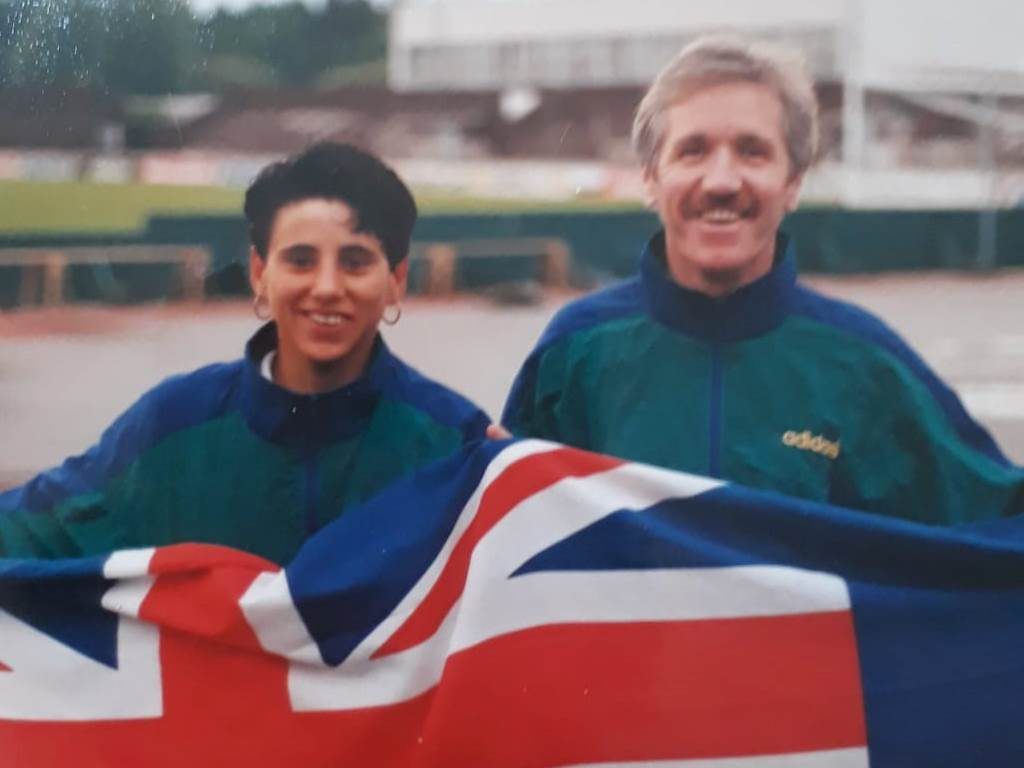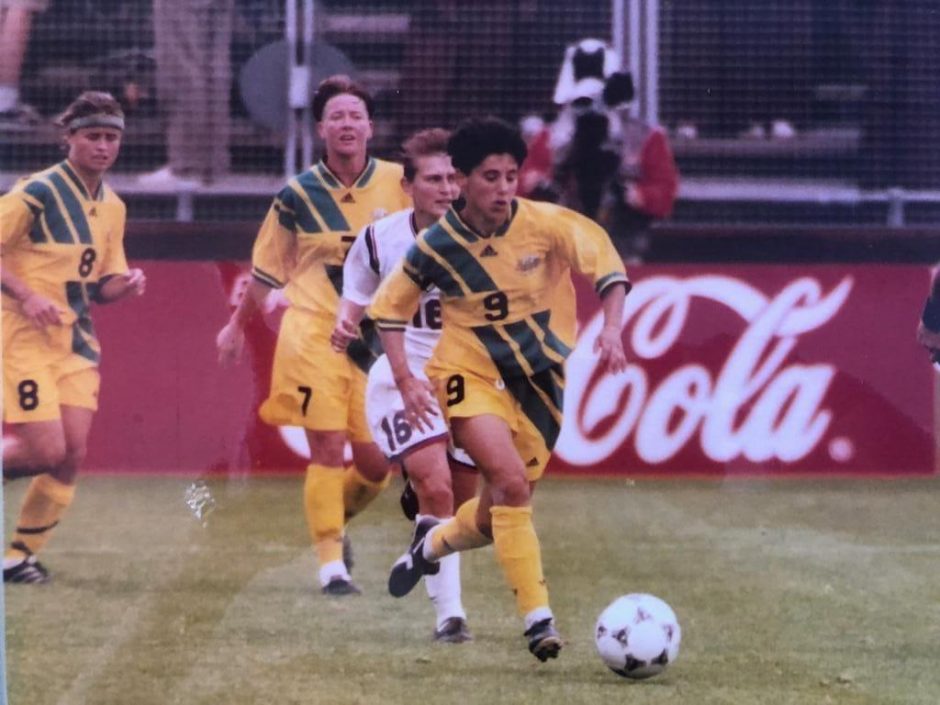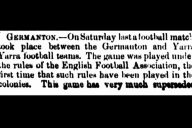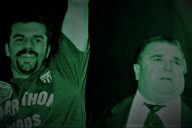Angela Iannotta’s historic, unseen goal: the story of Australia’s first ever World Cup goalscorer in her own words
Like people, no two goals are alike. Each is unique, with its own characteristics and meaning. One of the characteristics of the goal Angela Iannotta scored against China was that it was beautiful. Angela says so herself. It was also a special goal. Momentous. No other Australian player had scored a goal like this before. But we don’t know that much about it. It’s a slice of Australian football history hidden from sight.
“It was a brilliant goal that one. I think I started on the bench that game and I came on I think in the 1st half, not sure for what reason, maybe someone got injured. We were losing 1-0 I think and then there was this loose ball right on the edge of the penalty box. I remember it was two-touch, I stopped it and then I kicked the hell out of the ball and it ended up in the top corner. It was right in the top right hand corner, or was it left hand corner? I stopped it and whacked it in and I remember my teammates trying to catch me because I was running like mad towards the bench. That was exciting, but in the end we lost 4-2. But that’s alright,” Angela tells Shoot Farken.
What Angela is describing is the first goal scored by Australia in a FIFA Women’s World Cup tournament. Actually, it’s the first Australian goal scored at a senior men’s or women’s World Cup. The Socceroos, valiant as they were, didn’t manage to get on the scoresheet in 1974. Three games, zero goals.
It would be the Matildas, 21 years later at the 1995 Women’s World Cup finals held in Sweden and Norway, who would break that particular duck. Specifically, it would be the Matildas’ 24-year-old striker born in the Victorian country town of Myrtleford, who grew up playing her football in the Albury-Wodonga women’s league, first with Melrose Park Rangers and then with Albury City and Albury United.
It’s a long time since Angela has seen that goal. Both she and I searched for it in vain on YouTube. She thinks she might have a copy on a VHS cassette somewhere back in Albury. She would have to check next time she was back there, maybe get it converted to digital and uploaded to YouTube for the world to see.
There is footage of her playing at that 1995 World Cup for the Matildas. It shows a diminutive, darting, two-footed number nine with a silky touch. She looks wonderful. Relaxed on the ball. A born footballer. You can see her set up Australia’s first goal against the reigning World Cup holders of the time, the formidable United States team containing titans of the women’s game like her opposing number nine Mia Hamm.
“It was that punishing and penetrating run from Iannotta, who has probably been the best Australian player, the cross was excellent, Webber stayed on her line and was beaten by Casagrande,” the commentator tells us. “And 1-0 Australia, what a shocking score.”
The goal, scored by Lisa Casagrande at around the 54-minute mark, shocked the US out of their slumber. Stung into action, the Americans put away four goals during the last 25 minutes of the match to end the Matildas’ dream of a giant-killing upset. It would also end Australia’s time at the tournament, having lost 5-0 to Denmark, 4-2 to China, and 4-1 to the US. She says the US “were probably the toughest team I’ve played against.”
There’s another video on YouTube of Angela at that World Cup. It’s produced by ISL Marketing AG Soccer Learning Systems and looks to have been assembled not long after the 1995 tournament. It’s called ‘Dream Team: The Stars of the 1995 Women’s World Cup’. Again, sadly, there’s no sign of that goal against China.
Coming into that World Cup, Angela had won the Serie A championship with her Italian club ACF Agliana in the 94-95 season. She had a Scudetto under her belt and a strong showing at the World Cup had further raised her profile in the women’s game. She was on top of the world. The girl from Albury had come a long way.
Beginnings in Albury
As a girl growing up in the regional border town of Albury-Wodonga, which straddles the Murray River, there was not a lot pointing to Angela one day representing her country on the world stage. She started kicking the ball around with her brothers as a kid on the family farm, but unlike now, there was little encouragement for girls to take up the game, let alone flourish.
“It was hard in Albury-Wodonga. There was only six or seven girls teams and the competition was bad and we didn’t have good coaching; we didn’t have coaching at all. Where I got to, I was just lucky because I had a bit of natural talent. I was also fast, which helped. But my big problem was my father never wanted me to play. He was very against it.”
The first indication Angela was something a little bit out of the ordinary came when she tried out for her school’s girls soccer team at Murray High School. She was in year 7, but as she remembers it, the team only took players starting from year 9. Instead of waiting two years, she persisted and her P.E teacher gave her a go.
“I think I bugged him until he just said ‘OK, OK’. Then he saw me play and he was like ‘Ah nah, nah, we have to let her play!’ I have a lot to thank that teacher. He came home to my place a year later and talked to my dad and told him I was a good little player and to let me play. That kind of softened my dad a little bit. He was proud to hear someone say I was alright and he came around a bit. So I have a lot to thank that teacher for,” Angela says.
Angela’s game continued to improve. She was fast outgrowing the limited challenges of the Albury-Wodonga league and by her mid-teens she had made her way into the Australian Capital Territory rep squads, as Albury-Wodonga was affiliated with the A.C.T federation at the time. This led her to play at national championships, where her talent was noted by Steve Darby, the Australian Soccer Federation’s technical director and a coach in the women’s national team set up.
Still playing in the Albury-Wodonga league, she got a call-up to the under 18 women’s national team and started to make appearances for the national B-team under Darby. She made her full international debut in October 1991 against New Zealand in the Oceania World Cup Qualifiers in Sydney. Disappointment followed, however, when Australia failed to qualify, as New Zealand pipped the Aussies for qualification on goal difference.
“I think Steve Darby selected me in 1989 for a tour to Japan. And then we did the 91 World Cup qualifiers with Steve, so I turned 18 when I was in the national team. I was in the B-team. We had a comp in Brisbane and I remember there was an A and B team and I was in the B-team. From there I moved into the national team, the A-team. But it was hard. I was still playing in Albury-Wodonga and even physically, it was tough. I was never the most resilient of players, so it was a different level,” she says.
Without anything like the current day W-League, Australia’s women players at the time either played in their state league competitions or the more ambitious would try their luck overseas. Similar to the Australian male players of the era, moving overseas to find a club and play professionally was difficult for female players. Leagues in the Scandinavian countries, the US and Japan offered some kind of at least semi-professional option that did not yet exist in Australia.
Calcio femminile
For Angela, her foray into playing football abroad came about almost by accident. “My older brother Paul went to Italy for a holiday and that was in June 1992, and I was like, can I come too? And he said, yeah you can come,” she says. “It was Agliana, they had just got promoted to Serie A. So we get over there and I’m talking to my uncle about how much I love playing and before I know it he’s organised a trial for me at Agliana!”
Angela’s holiday to Italy soon turned into a four-year stint with Agliana, culminating in the club winning Serie A in 1994-95. She credits her move to Italy with deepening her appreciation for the game and understanding of what it takes to perform at the highest level. “That’s where I realised what was involved in playing and being part of a team. That’s when I got to really understand how football is played,” she says.
At Agliana, Angela got to play with some of the legends of Italian women’s football, including the incomparable Carolina Morace, who played 150 times for the Italian national team and scored 105 international goals. Morace had made her national team debut as a 14-year-old in 1978 and went on to break all kinds of records in Italian and European women’s football. In 1999, she even became the first woman to coach a professional men’s team and she is the current head coach of the AC Milan women’s team.
Another teammate at Agliana was Milena Bertolini, the current Italian women’s team national coach, who Angela also counts as a very good friend. “We played two seasons together. I remember she was a very good player and she’s a great coach. She’s brilliant.”
This was a massive step up in class from the Albury-Wodonga league, where Angela had been playing her club football with Albury United. Angela’s progress was recognised back home in Australia and she became a staple in national team coach Tom Sermanni’s line-ups. She carried her form from Serie A into the World Cup.

Angela Iannotta with Matildas coach Tom Sermanni
Japan and two unwelcome breaks
In 1996, she left Italy for Japan and a chance to play in the L-League for Panasonic Bambina during the 1996/97 season along with Australian teammates Cheryl Salisbury and Sunni Hughes. “After the 1995 WC I was at my peak and then I signed a contract to play in Japan and I was earning $50,000 a year, which was big money in women’s football at the time. They paid for my accommodation, food, everything.”
She recalls her early days in Japan fondly. “My first game in Japan and I scored my first goal. We were playing with Mt Fuji in the background. Sunni Hughes crossed the ball in and I scored with a diving header. It was just a beautiful moment.”
But the good times soon ended. The next couple of years would be a struggle for the skilful striker as she battled successive injuries. A month before going to the Olympics in 1996, the Australian team toured the US. Disaster struck.
“I broke my leg, my fibula, in training. The next two years were very hard for me. I missed a lot of Australian games. I went back to Japan. They were saying you’re not ready to play, you’re not ready to play, you’re not ready to play, and so I came back to Australia and asked the physios here, what’s going on with my leg? The national team doctor said, Ange you’re ready to play. Alright, went back to Japan, I played 5-6 games, scored about 5 goals.
Seven or so months later. Disaster again.
“The season was over by the end of January and I went to Italy for a holiday. I was training with one of my old clubs in Tuscany. I don’t know what happened but I broke my fibula again, the one I broke with the national team. It just went crack. One of the girls kicked me on the back of my heel and I put my foot down and I just heard a crack.”
The double break to her fibula derailed her time in Japan and put her on the outer with the national team too. Tom Sermanni had moved on as Matildas boss and Greg Brown had taken over. “I got back into the national team but physically it was hard,” she says.
She says the training regime with the national team didn’t help her return to her best. “I don’t think the training sessions with the national team helped me. There was a lot of gym work but I needed to play. You need to play football. You need to train but you need to play constantly. To be at a top level you need to play week in and week out, not just train. I went to the 1999 World Cup with Brownie (Greg Brown), but physically and mentally I was not at my best. I didn’t play much. I was mainly on the bench.”
Arrivederci to the Matildas
Following the 1999 World Cup, Australia had another new coach, Chris Tanzey. Angela wasn’t part of his plans for the future of the team. “Chris Tanzey came in but we never really got along. He dropped me from the squad and he said you can try out for the squad. I said I’ve had enough and went back to Italy and played until about 2010.”
Missing the 2000 Olympics in Sydney was a bitter disappointment for Angela. “That was mine and everyone’s dream. That was a bit sad. But I just knew Chris wouldn’t pick me. We didn’t get along and I didn’t like his coaching style.”
She returned to Italy and played for another two years before becoming a player/coach with her club Autolelli Picenum CF. “I played two more years in Serie A and then the club I was playing for was relegated to Serie B for financial reasons. The club had to get rid of our coach so the president turned to me and asked if I wanted to do it. So I coached for 8 years. I got my UEFA B certificate, which is good. But from 2010 to today I’ve been out of football,” she says.
Angela settled in a small beachside town halfway between Pescara and Ancona on the Adriatic coast. These days she keeps busy and fit by participating in triathlons. She loves her life in Italy but still keeps an eye on what’s going on in Australia with women’s football. She says women’s football in Italy, Australia and around the world has changed since the 1990s mainly because of the money coming into the game. She says the big clubs in Italy like Juventus, Roma, Fiorentina and others have started to take women’s football seriously, which is driving the move to professionalism, with better facilities and playing standards becoming the norm.
She’ll be at the Australia versus Italy match on Sunday. She says her heart is with Australia but she wants Italy to do well. “It would be good to see both of them get out of the group.” She says the game has progressed at the international level to the point where any number of countries might emerge as World Cup champions at this year’s tournament, including Australia, but she’s leaning towards France as possible winners.
As for that beautiful but now invisible goal she scored in the 1995 World Cup and her place in Australian football history. “I wasn’t aware at the moment but then I realised after a long while. But I didn’t really think too much about it as being history. It was exciting. The World Cups are always exciting.”
















